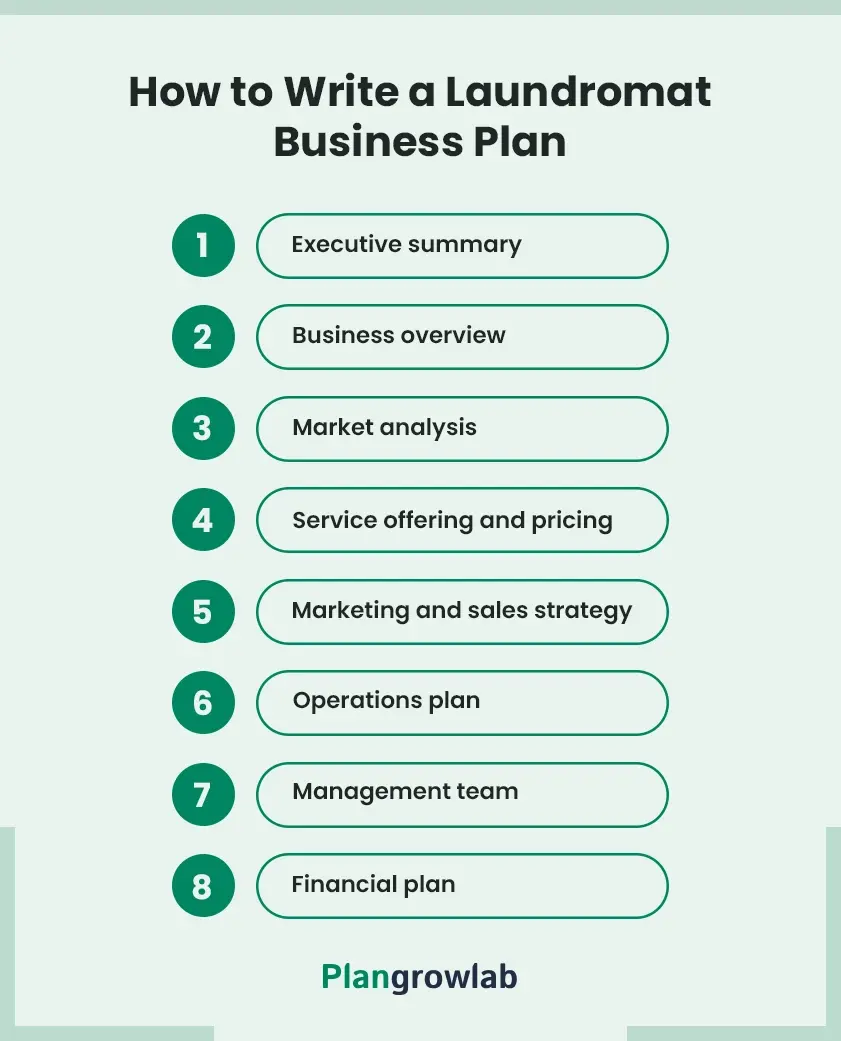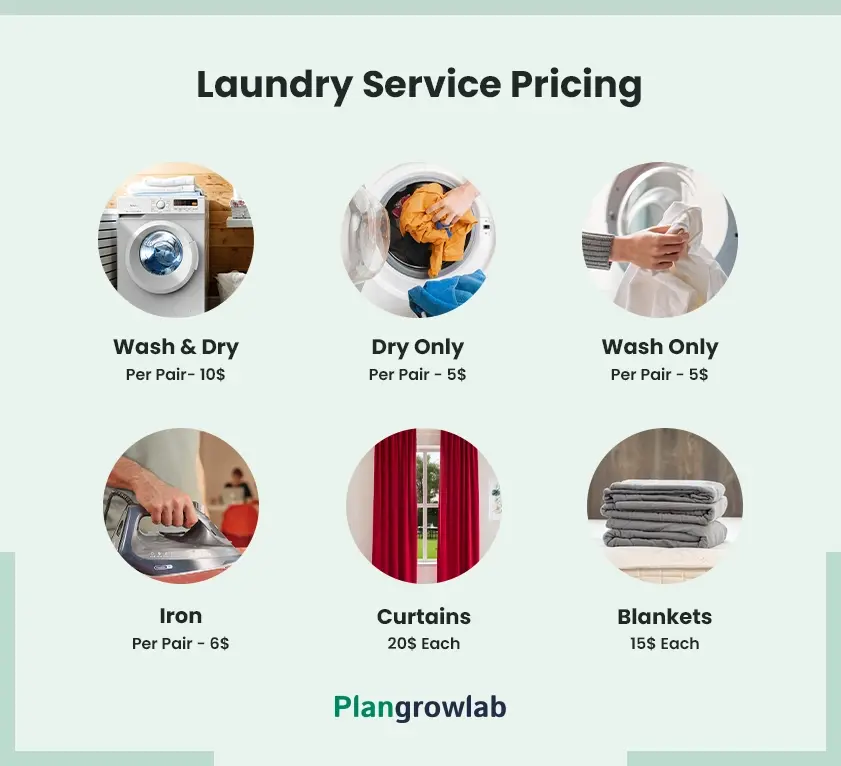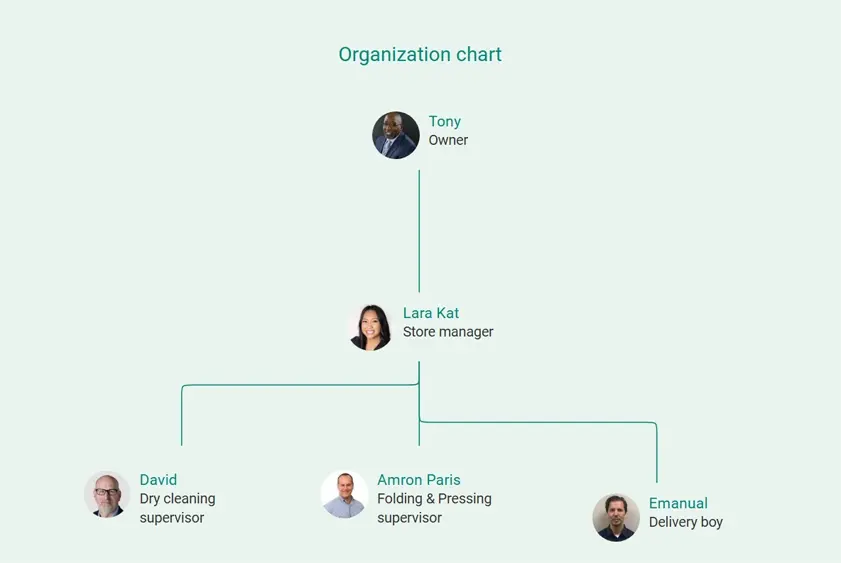Starting your own laundromat business can be a great source of consistent income and fill an essential need in your community.
But writing a business plan is intimidating, especially for a first-time business owner! And it was no exception for Courtney Satterlee, the owner of GB Laundry.
Recently, I had the opportunity to talk to Courtney about what it took for him to launch his laundromat and how he turned his vision into a successful business.
From that conversation, I have put together this laundromat business plan guide to help you craft your plan and overcome challenges as Courtney did.
Why you need a business plan for a laundromat
A good business plan is an essential document that gives you a clear path to guide your decision-making and grow your business further.
Applying the same to have a business plan for your laundromat will be important enough to ensure that it can succeed in the long term.
Whether you are opening a new laundromat or already run one, an effective business plan is going to act as a guide on how to manage and expand your business successfully.
Here’s how it helps you:
- Let you identify who the ideal customers are, know what service they require and then come to a decision on what one is offering, such as self-service machines, dry cleaning, wash and fold service, or pickup services.
- Allow you to estimate your initial costs, control your ongoing costs, and estimate your income to figure out when you will break even.
- Show potential investors or lenders that you have put a lot of effort into each detail, from market analysis to financial projections, increasing your chances of getting funding.
In short, writing a solid laundromat business plan will help you set a strong foundation for your laundromat.
How to write a laundromat business plan
When writing a business plan for your laundromat, focus on the key aspects that make your business concept clearly notable. Here’s a simple guide on how to draft each section:

1. Executive summary
An executive summary is the high-level introduction to your business plan that is relatively short. So, it’s your chance to let others get an overview of your laundromat business.
Though it comes first, it's better to write this section last after you've worked through all the other sections. In this way, you can summarize everything that you've mentioned in the rest of your plan.
Here’s what you should include in this section:
- Name, location, and ownership of the laundromat
- Services you will offer
- Who your customers are (location and what they need)
- How you will compete with other laundromats in the area
- Marketing strategies to bring in customers
- Bootstrapping costs and how much money you will need
Overall, this section is like an elevator pitch for your entire business plan. Hence, keep it short, clear, and interesting to grab the attention of investors or anyone interested in your business.
"The key to a strong executive summary is keeping it simple and to the point.
I focused on the growing need for convenient, affordable laundry services in our area, how we would meet that demand, and why our laundromat has a competitive edge.
My advice? Highlight what makes your laundromat unique, be honest about your goals, and make your vision clear from the start. This is what grabs attention and gets people interested in learning more about your business." —Courtney Satterlee
2. Business overview
This section gives a closer look at your laundromat business. The key points it discusses include the foundational facts and major details about your laundromat.
Start writing by presenting your business idea—what inspired you as well as the type of services you are planning to offer, such as laundry service, fold services, or delivery service.
Then, indicate whether it is an LLC, sole proprietorship, or partnership and the laundromat location. Point out why that particular spot is perfect for you.
Moreover, mention your vision and mission. What drives your laundromat and what's the future? Share your goals to help readers understand the bigger picture of what you're building.
If your laundromat is already operational, provide its story. When was it opened? How did it develop? Mention any significant milestones or success stories that indicate your achievement and credibility.
In simple words, the business overview section tells the story of your laundromat—why it exists, what makes it special, and where it's headed.
"When writing the business plan, I centered the business overview on the story of my laundromat—the 'why' to start it, what services set it apart, and vision for the future.
It's about connecting with people, showing them the heart of the business, and why it’s built to succeed." — Courtney Satterlee
3. Market analysis
Conducting a comprehensive market analysis is crucial for building a successful laundromat business.
It helps you understand the market landscape, identify potential customers, spot industry trends, and analyze the competition. This will enable you to position your business effectively.
A detailed market analysis shows investors and partners that you have done your research and are prepared to enter the laundromat industry with a strong strategic approach.
To make this section more impactful, consider answering the following questions:
- What is the size of the laundromat industry locally and nationally? Is it growing or declining?
- What trends are shaping the laundromat industry? Are customers seeking more eco-friendly services or modernized payment options?
- Who are your target customers? Families? College students? Busy professionals?
- What competitors are in your area? How do their services compare to what you’re offering?
- What makes your laundromat unique?
Lastly, don’t forget to state any specific regulations to run a laundromat, like local business licenses, environmental compliance, or health and safety standards.
Being ahead of all these will mean that your business is running smoothly without having any legal problems.
4. Service offering and pricing
This section forms the backbone of your laundromat business.
Begin with a clear description of the range of services you’ll offer, such as self-service washing and drying machines, along with any premium options like pickup and delivery or specialized laundry treatments.
Next, emphasize unique features, such as the use of "green" detergents, expert stain removal, or quick turnaround times, to provide added value for your clients.
In addition to that, specify what’s your pricing structure. Is it per load, per weight or a subscription-based for the repeat customers? It’s advisable to offer tiered rates for standard, premium, and express services so as to cut across all budgets.

If applicable, describe differentiating service features, such as loyalty programs, open 24/7 access, or family-friendly amenities.
Make sure your services and prices correspond to the target audience and local market needs, so your laundromat can stand out from its competitors.
5. Marketing and sales strategy
Your sales and marketing plan will help bring customers to your laundromat and keep them as repeat customers.
So, in this section, you must outline how you will advertise your business, reach out to your target market, and bring them back to your laundromat.
While planning this section, consider including the following strategies:
- Social media promotions
- Local advertising
- Referral programs
- Email campaigns
- Seasonal discounts
- Partnerships
Make an attempt to generate marketing strategies that would be acceptable for the needs and preferences of your target audience. Monitor the outcomes and adjust your approach based on what works best for you.
"When we first opened GB Laundromat, I knew we had something special, but spreading the word was a real puzzle.
Rather than relying on traditional ads, I wanted to build genuine connections with the community. We focused on social media outreach, creating engaging content that resonated with locals.
We also partnered with nearby cafes and retail shops to offer exclusive discounts, which helped us connect with new customers and build lasting relationships in the neighborhood." —Courtney Satterlee
6. Operations plan
Your operations plan clearly describes how your laundromat will run on a daily or weekly basis. It helps you outline how you will efficiently manage your laundry services and operations.
Hence, try to answer a few questions while drafting this section:
- How often will you clean and maintain your machines?
- Do you require staff to help with washing, folding, or customer service, or will you run it yourself?
- How will you manage supplies on laundry detergent, fabric softener, etc?
- What tracking and monitoring systems will you put up to ensure customer usage as well as the availability of the machines?
- Where will you put your supplies, and how will you ensure efficient inventory management?
- How will you handle customers' complaints or issues with machines?
- What is your plan regarding regular laundry equipment maintenance and repairs?
By adding these points, you may develop a clear operations plan for your laundromat, showing potential stakeholders that it runs smoothly and efficiently.
"Running a laundromat requires careful attention to daily tasks—keeping machines clean, managing inventory, and ensuring a great customer experience.
To make sure everything runs smoothly, it's important to establish clear processes for machine maintenance, staffing, and inventory tracking.
A strong operations plan will help keep things running efficiently and ensure your customers keep coming back." –Courtney Satterlee
7. Management team
This section of your laundromat business plan will focus on who will run the business. Whether it's you or a small team, it's worth showing you have the right people to take this business forward.
Begin by introducing yourself. Talk about any experience or skills related to running a laundromat. You may include a background in customer service or management.
Explain what roles other key members of the team, such as managers or staff, will play and how their experience will help the business grow.
You can include an organizational chart to show your hierarchical structure and how decisions will be made. Something like this:

If you have any outsider such as a business consultant or advisor, state them as well. Explain how they’ll help your laundromat succeed.
“From day one, I knew that having the right people in place would make all the difference.
I started by bringing in a skilled operations manager who has years of experience in the laundry business.
We also hired customer service experts who understand how to make our clients feel welcome and valued. With a team like this, we were able to set up clear roles and responsibilities, ensuring smooth daily operations.
Having this solid team structure helped us stay focused on growth while maintaining excellent service." —Courtney Satterlee
8. Financial plan
This portion deals with the financial aspects of your laundromat businesses, providing projections over the next 3 to 5 years.
An in-depth financial plan will let potential investors and lenders analyze whether your laundromat is financially sound or if it is likely to generate profits.
So, your laundromat financial plan should comprise several key financial statements and projections, such as:
- Income statement (profit and loss statement)
- Projected cash flow statement
- Break-even analysis
- Balance sheet
- Financial needs and use of funds
Also, provide startup cost estimates, revenue estimates, and sales forecasts. And don’t forget to include a scenario analysis, along with what different potential outcomes might be.
It’s advisable to use conservative financial estimates, especially during the first year of operation, as overpromising and underperforming can be a problem in dealing with investors.
“Instead of going for overly optimistic numbers, we focused on creating realistic projections, including a detailed income statement and cash flow forecast.
We also accounted for the startup costs and planned for unexpected expenses, ensuring that we’d have a buffer in the early months.
By taking a conservative approach, we were able to show investors we were ready for both the challenges and growth ahead." —Courtney Satterlee
Download our laundromat business plan template
Are you ready to craft your laundromat business plan from scratch? But not sure how to get started? Not to worry: download our free laundromat business plan template in PDF.
This investor-ready template has helped thousands of laundromat owners to get started, and I hope it will help you as well. Use it as a reference while crafting your laundromat business plans, and customize them as per your business needs.
Conclusion
After exploring this detailed guide and downloading the free template, you're now well-equipped to create your own laundromat business plan.
However, if you ever feel stuck or need expert-level guidance, consider reaching out to top business plan consultants. Our team of experts will help you refine your plan and ensure it stands out to investors.
So, why wait? Take the first step and start planning your laundromat business today!
Frequently Asked Questions
What are the key components of a laundromat business plan?
The following are the key components to include in a Laundromat business plan:
- Executive summary
- Business overview
- Market analysis
- Service offering and pricing
- Marketing and sales strategy
- Operations plan
- Financial plan
- Management team
How do you get funding for your laundromat business plan?
There are several ways to get funding for your laundromat:
- Small business loan
- Investors
- SBA Loans
- Grants
- Equipment financing
Where can I get a laundromat business plan PDF?
You can find laundromat business plan templates in PDF from these sites: Upmetrics, Bizplanr, Bplans, or LivePlan.
How often should I update my laundromat business plan?
It’s advisable to review and update your laundromat business plan regularly, at least once a year, or more often —whenever significant changes happen in your business environment.

